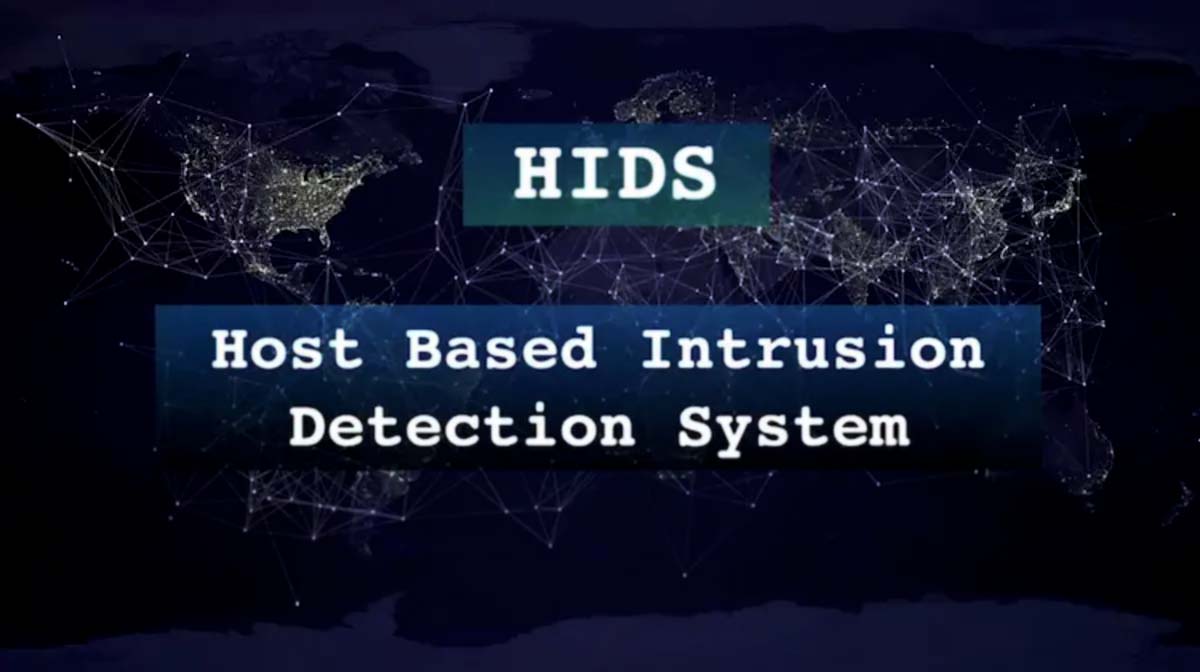Home>Home Security and Surveillance>What Do Host-Based Intrusion Detection Systems Rely Upon To Perform Detection Activities


Home Security and Surveillance
What Do Host-Based Intrusion Detection Systems Rely Upon To Perform Detection Activities
Modified: March 6, 2024
Looking to enhance your home security and surveillance? Discover how host-based intrusion detection systems rely on advanced technologies for detection activities.
(Many of the links in this article redirect to a specific reviewed product. Your purchase of these products through affiliate links helps to generate commission for Storables.com, at no extra cost. Learn more)
Introduction
In today’s rapidly evolving digital landscape, ensuring the security of our homes is of paramount importance. With increasing instances of cyberattacks and physical breaches, protecting our property, belongings, and loved ones has become a top priority. This is where home security and surveillance systems come into play, providing us with the necessary tools and technologies to safeguard our homes.
Home security and surveillance systems encompass a wide range of devices and technologies that work together to detect, deter, and respond to potential threats. From traditional alarm systems to cutting-edge smart home solutions, these systems have evolved to cater to the specific security needs of modern homeowners.
In this comprehensive guide, we will delve into the key components of home security and surveillance systems, exploring the latest advancements and highlighting essential features that homeowners should consider. Additionally, we will discuss the importance of proactive security measures, such as host-based intrusion detection systems (HIDS), to ensure comprehensive protection against potential threats.
HIDS, a critical component of any robust home security system, rely upon various detection activities to identify and mitigate security breaches. By understanding how HIDS operate and the methodologies they employ, homeowners can make informed decisions and optimize their home security measures for maximum effectiveness.
Throughout this guide, we will explore the inner workings of HIDS, including the different types of detection techniques and the challenges involved in implementing such systems. From signature-based detection to behavior-based analysis, we will unravel the mechanics behind HIDS and shed light on their role in ensuring the safety and security of our homes.
So, whether you are a homeowner looking to upgrade your security system or a security professional seeking insights into the latest trends and technologies, this guide will provide you with a comprehensive and insightful overview of host-based intrusion detection systems and their role in home security.
Key Takeaways:
- Host-Based Intrusion Detection Systems (HIDS) are like security guards for our digital devices, constantly watching for any unusual activities that could signal a potential threat to our homes.
- HIDS use advanced detective skills to keep our homes safe, analyzing everything from file changes to network traffic to catch any sneaky attempts to breach our security.
Host-Based Intrusion Detection Systems (HIDS)
Host-Based Intrusion Detection Systems (HIDS) are a vital component of modern home security and surveillance systems. HIDS are designed to monitor and analyze the activities within an individual host or device, such as a computer or a smart home device, to detect any potential intrusions or unauthorized access attempts.
Unlike network-based intrusion detection systems (NIDS), which focus on monitoring network traffic and detecting attacks at the network level, HIDS operate directly on the host they are installed on, enabling them to monitor and protect the host’s internal processes, applications, and files.
The primary objective of HIDS is to proactively identify any anomalous or malicious activities occurring within a host and take appropriate action to mitigate the potential risks. By continuously monitoring the host’s behavior, HIDS can detect known attack patterns, unusual activities, unauthorized access attempts, and suspicious system configurations.
By implementing HIDS as part of a comprehensive home security system, homeowners can gain greater control and visibility over their devices and networks, enhancing their overall security posture.
HIDS rely on various detection activities to perform their monitoring and analysis tasks, ensuring the detection of potential threats and intrusions. These activities include signature-based detection, anomaly-based detection, and behavior-based detection techniques.
Signature-based Detection: This technique involves comparing the behaviors and characteristics of system activities against a database of known attack signatures or patterns. HIDS use these signatures as a reference to identify and detect known malicious behavior.
Anomaly-based Detection: Unlike signature-based detection, anomaly-based detection focuses on monitoring deviations from normal system behavior. HIDS establish a baseline of normal activities and compare ongoing behaviors to this baseline. If any abnormal behaviors are detected, it raises an alert, indicating a potential security incident.
Behavior-based Detection: Behavior-based detection goes a step further than anomaly-based detection by focusing on the specific behaviors and actions of users and processes within the host. By monitoring user activity and process actions, HIDS can identify suspicious or malicious behavior, such as unauthorized access attempts or unusual privilege escalation.
In addition to these detection techniques, HIDS rely on several key components and technologies to perform their monitoring and analysis tasks. These include log analysis, system call monitoring, file integrity checking, and network traffic monitoring.
In the upcoming sections, we will explore each of these components in detail, understanding how they contribute to the overall detection capabilities of HIDS and their importance in maintaining a secure home environment.
Importance of Detection Activities
Detection activities play a crucial role in the effectiveness of host-based intrusion detection systems (HIDS) as part of a comprehensive home security solution. By actively monitoring and analyzing the activities within a host, HIDS can quickly identify potential security threats and take appropriate action to mitigate risks.
One of the primary reasons detection activities are essential is their ability to identify known attack patterns and signatures. Signature-based detection allows HIDS to compare system activities against a database of known attack patterns. By detecting these signatures, HIDS can promptly alert homeowners of potential security breaches and initiate appropriate countermeasures.
However, relying solely on signature-based detection may not be sufficient to safeguard against emerging and unknown threats. This is where anomaly-based detection becomes vital. By establishing a baseline of normal system behavior, HIDS can identify any deviations from this baseline as potential security incidents. Anomaly-based detection helps uncover new and zero-day attacks that may not have known signatures, enhancing the overall detection capabilities of HIDS.
Behavior-based detection is another critical detection activity that helps identify suspicious activities within a host. By monitoring user behavior and process actions, HIDS can spot unusual patterns, unauthorized access attempts, or privilege escalation. This proactive approach ensures that potential threats are detected before they can cause significant harm to the host or the home network.
By implementing these detection activities, homeowners can gain several benefits in terms of home security:
- Timely Detection of Threats: Detection activities enable HIDS to detect potential security threats in real-time. By quickly identifying suspicious behavior or known attack patterns, homeowners can take immediate action to mitigate the risk and prevent unauthorized access or damage.
- Proactive Threat Hunting: Detection activities support proactive threat hunting by continuously monitoring and analyzing the behavior of the host. This allows for the early detection of emerging threats or security vulnerabilities, enabling homeowners to address these issues before they can be exploited.
- Enhanced Incident Response: When a security incident occurs, detection activities provide crucial information about the nature of the threat and its impact on the host or network. This enables homeowners to respond efficiently and effectively, minimizing the potential damage and restoring the security of their home environment.
- Improved Security Awareness: Detection activities provide homeowners with insights into the various types of threats and attack vectors that pose a risk to their home security. This awareness helps homeowners make informed decisions about security measures and enables them to take proactive steps to strengthen their overall security posture.
- Compliance and Auditing: Detection activities contribute to compliance requirements by ensuring that security events are properly logged, monitored, and reported. This is particularly important for homeowners who need to comply with industry regulations or meet the security standards set by their insurance providers.
By recognizing the importance of detection activities and incorporating them into their home security systems, homeowners can significantly enhance the protection of their homes and safeguard their invaluable assets and loved ones.
Components of Host-Based Intrusion Detection Systems
In order to effectively monitor and analyze the activities within a host, host-based intrusion detection systems (HIDS) rely on several key components. These components work together to ensure comprehensive detection and protection against potential security threats.
Let’s explore the essential components of HIDS:
- Log Analysis: Log analysis is a critical component of HIDS that involves monitoring and analyzing log files generated by various system components and applications. These logs provide valuable information about system events, user activities, and application behavior. By analyzing the logs, HIDS can identify anomalies, unauthorized access attempts, and suspicious activities that may indicate a security incident.
- System Call Monitoring: System call monitoring involves monitoring the low-level interactions between the operating system and the applications running on the host. HIDS intercepts system calls and analyzes them to detect any abnormal or malicious behavior. By monitoring system calls, HIDS can identify common attack techniques, such as buffer overflow or privilege escalation attempts.
- File Integrity Checking: File integrity checking is a vital component of HIDS that ensures the integrity and security of system files and critical configuration files. HIDS maintains a database of file hashes, which are used to compare the current states of files against their known secure states. Any unauthorized modifications or tampering with files can raise an alert, indicating a potential security breach.
- Network Traffic Monitoring: Although HIDS primarily focus on host-level activities, they can also monitor network traffic originating from or destined to the host. By analyzing network packets, HIDS can identify suspicious communication patterns, known attack signatures, and unauthorized connections. Network traffic monitoring provides additional visibility and detection capabilities to protect against network-based attacks.
- Alert Generation and Response: When a potential security threat is detected, HIDS generates alerts to notify homeowners or security personnel. These alerts provide detailed information about the nature of the threat, the affected host, and the potential impact. Based on the severity of the alert, appropriate response measures can be taken, such as isolating the host from the network, blocking suspicious IP addresses, or initiating incident response procedures.
By leveraging these components, HIDS can effectively detect and respond to potential security threats within a host. They provide homeowners with valuable insights into the activities occurring within their devices, enabling proactive measures to mitigate risks and strengthen overall security.
It’s important to note that the effectiveness of HIDS depends not only on the individual components but also on how they are configured, calibrated, and integrated into the overall home security system. Regular updates, patch management, and continuous monitoring are essential to maintain the optimal performance and accuracy of HIDS components.
In the following sections, we will explore in detail the different detection techniques employed by HIDS, including signature-based detection, anomaly-based detection, and behavior-based detection. Understanding these techniques will further enhance our understanding of how HIDS operate and contribute to overall home security.
Signature-based Detection
Signature-based detection is a fundamental technique used by host-based intrusion detection systems (HIDS) to identify known attack patterns and signatures. This technique involves comparing the behaviors and characteristics of system activities against a database of known attack signatures or patterns.
The database of signatures serves as a reference point for HIDS, enabling them to quickly identify and classify suspicious activities based on their similarity to known malicious behaviors. This approach is effective for detecting well-known and widely-used attack techniques, such as specific malware variants, common exploit frameworks, or known command injection attempts.
Signature-based detection relies on having an up-to-date and comprehensive database of attack signatures. These signatures are generated and continually updated by security researchers and organizations, who analyze and document the behaviors of known malware, viruses, or other malicious activities.
When HIDS encounters a system event or activity, it compares the relevant attributes of that event against the signatures in its database. If a match is found, it indicates that the observed behavior aligns with a known attack pattern, triggering an alert or further action.
The effectiveness of signature-based detection lies in its ability to identify known threats with a high degree of accuracy and efficiency. It minimizes false positives and false negatives by specifically targeting previously identified threats.
However, there are some limitations to consider when relying solely on signature-based detection:
- Limited to Known Signatures: Signature-based detection can only identify threats for which specific signatures are available. Emerging or zero-day attacks that have no known signatures may go undetected until new signatures are developed and added to the database.
- Intolerance to Variants: Attackers often modify or obfuscate their malicious codes to create variants that evade signature-based detection. This allows them to bypass traditional security measures that rely solely on signature matching.
- Static Nature: Signatures are static and don’t account for evolving attack techniques. As attackers continuously develop new tactics, signature-based detection may struggle to keep pace with the constantly changing threat landscape.
- Detection Latency: Signature-based detection may introduce a certain amount of latency in responding to new threats. The time required to analyze, develop, and distribute new signatures can create a window of vulnerability during which emerging threats could go undetected.
Despite these limitations, signature-based detection remains an important and effective component of HIDS. It serves as the first line of defense against known threats and provides quick and reliable identification of established attack patterns.
In combination with other detection techniques, such as anomaly-based and behavior-based detection, signature-based detection enhances the overall detection capabilities of HIDS, offering a multi-layered security approach to protect homes and ensure the safety of residents and their assets.
Anomaly-based Detection
Anomaly-based detection is a critical technique employed by host-based intrusion detection systems (HIDS) to identify potential security threats and attacks that may not have known signatures or patterns. Unlike signature-based detection, which focuses on matching system behaviors to known attack signatures, anomaly-based detection relies on establishing a baseline of normal system behavior and identifying deviations from this baseline.
Anomaly-based detection works by monitoring and analyzing various attributes and characteristics of system activities, such as resource utilization, network traffic patterns, user behaviors, and application interactions. By establishing a baseline of normal behavior, HIDS can then detect any abnormal or unusual activities that deviate from this baseline.
These anomalies may indicate potential security incidents, as they may be indicative of zero-day attacks, new attack vectors, or unauthorized activities within the host. Anomaly-based detection helps identify previously unknown threats that have not been documented or have no known signatures.
Establishing a baseline of normal behavior is a critical step in anomaly-based detection. HIDS must continuously observe and analyze the behavior of the host, learning and adapting to normal patterns as they occur. This allows the system to adapt to changes in system behavior caused by legitimate user activities or system updates.
When anomalous activities are detected, HIDS generates alerts or triggers further investigation. The severity of the alert depends on the magnitude and nature of the deviation from normal behavior. This allows homeowners or security personnel to take appropriate action, such as blocking suspicious network connections, isolating the host, or launching incident response procedures.
When using anomaly-based detection, it’s important to consider the following challenges:
- Baseline Customization: Setting an accurate baseline and ensuring that it reflects the normal behavior of the specific host can be challenging. Configuring the baseline requires careful calibration and continuous monitoring of system activities.
- False Positives and False Negatives: Anomaly-based detection can generate false positives when legitimate behaviors are misclassified as anomalies, resulting in unnecessary alerts. Conversely, it may also generate false negatives when subtle anomalies go unnoticed due to a lack of customization or sensitivity.
- Data Overload: Analyzing potentially vast amounts of data generated by system activities can become overwhelming. Implementing effective analytics and machine learning algorithms can help streamline the process and focus on the most relevant anomalies.
- Dynamic Environments: Host environments are not static, and system behavior can evolve over time due to software updates, changes in user behavior, or varying network conditions. Anomaly detection systems need to adapt and be able to differentiate between legitimate changes and actual anomalies.
Despite these challenges, anomaly-based detection is a valuable technique, enabling HIDS to identify previously unknown threats and respond to emerging attack patterns. By complementing signature-based detection with anomaly-based detection, HIDS can provide a comprehensive approach to home security, enhancing the protection of homes, assets, and residents against potential security breaches.
Behavior-based Detection
Behavior-based detection is a crucial technique utilized by host-based intrusion detection systems (HIDS) to identify suspicious or malicious behaviors within a host. Unlike signature-based detection that relies on known attack patterns or anomaly-based detection that focuses on deviations from normal behavior, behavior-based detection specifically targets the actions and behaviors of users and processes within the host.
Behavior-based detection monitors and analyzes user activities, system processes, and the interactions between them to identify behaviors that may indicate unauthorized access attempts, privilege escalation, or other malicious activities. By understanding the expected behavior of users and processes, HIDS can detect deviations that suggest potential security incidents.
Behavior-based detection works by establishing a baseline of normal behavior for each user and process within the host. This baseline is determined by analyzing historical data and typical patterns of behavior. Any actions or behaviors that fall outside the established baseline are flagged as suspicious and may trigger an alert or further investigation.
Examples of behaviors that behavior-based detection systems may monitor include:
- Login and Authentication: Monitoring login attempts, login times, and failed authentication attempts can help detect brute force attacks or unauthorized login attempts.
- Privilege Escalation: Keeping an eye on changes in user privileges or attempts to escalate privileges can help identify suspicious activities that may indicate an attacker trying to gain unauthorized access.
- Abnormal Resource Access and Use: Monitoring unusual resource accesses, excessive file modifications, or unusual network communication can indicate potential data exfiltration or suspicious activities by malicious entities.
- Process Monitoring: Analyzing the behaviors and interactions of system processes can help identify suspicious processes, injection attacks, or instances of process hijacking.
- Command and Code Execution: Detecting certain commands or code execution that go beyond normal operations can help uncover unauthorized activities or the presence of malicious scripts or codes.
Behavior-based detection can provide valuable insights and early warnings for potential security incidents. By continuously monitoring user and process behaviors, HIDS can identify suspicious actions and behaviors, enabling homeowners or security personnel to respond proactively and mitigate risks before significant damage occurs.
However, there are certain challenges associated with behavior-based detection:
- False Positives: Behavior-based detection relies on establishing accurate baselines for normal behavior. Any deviations from the baseline may trigger alerts, but not all deviations are necessarily indicative of malicious activities. Fine-tuning the detection thresholds and reducing false positives is crucial.
- Visibility and Context: Understanding the context and intent of user actions can be challenging. Behavior-based detection systems need to consider the user’s role, system functions, and legitimate reasons for unusual behaviors to avoid misidentifying normal activities as malicious.
- Advanced Evasion Techniques: Sophisticated attackers may attempt to evade behavior-based detection by carefully crafting their actions to mimic normal behavior or by gradually escalating their activities to avoid detection. HIDS need to continually adapt and update their behavioral models to stay ahead of evolving attack techniques.
- Complexity and Scalability: Monitoring and analyzing user and process behaviors in complex and large-scale environments can be challenging. Implementing robust analytics and machine learning algorithms can help handle the complexity and scale of behavior-based detection.
Despite these challenges, behavior-based detection remains a valuable component of HIDS, contributing to the overall security of homes and protecting against unauthorized access or malicious activities. By combining behavior-based detection with other detection techniques, such as signature-based and anomaly-based detection, HIDS offer a comprehensive security approach, ensuring a safer and more secure home environment.
Host-based intrusion detection systems rely upon monitoring and analyzing activities on a single host, such as file changes, system calls, and network traffic, to detect and respond to potential security threats.
Log Analysis
Log analysis is a critical component of host-based intrusion detection systems (HIDS) that involves monitoring and analyzing log files generated by various system components and applications within a host. These log files contain valuable information about system events, user activities, network traffic, and application behavior, which can be analyzed to detect potential security incidents or anomalous behaviors.
Logs serve as a detailed record of activities occurring within the host, capturing timestamps, source IP addresses, user actions, system processes, network connections, and more. By analyzing log data, HIDS can gain insights into the security posture of the host and identify abnormal or suspicious activities that may indicate a security breach.
Log analysis plays a vital role in detecting a wide range of security events, such as unauthorized access attempts, privilege escalation, malicious file modifications, unusual user behaviors, or network anomalies. By correlating events across different log sources, HIDS can uncover patterns and relationships that may not be apparent when analyzing individual logs in isolation.
Effective log analysis involves several key steps:
- Collection: HIDS collects logs generated by various system components, including the operating system, applications, network devices, and security tools. Centralizing the collection of logs ensures that all relevant data is available for analysis.
- Normalization: Log files often contain different formats and structures. Normalization involves converting log entries into a common format, making it easier to analyze and correlate events across different log sources.
- Storage: Logs are typically stored in a secure and centralized repository for long-term retention. This allows for historical log analysis and supports forensic investigations when necessary.
- Processing and Analysis: Log analysis tools and techniques are used to parse and analyze log data, extracting relevant information and looking for patterns and anomalies that may indicate security incidents or breaches. This may involve the use of machine learning algorithms or rule-based detection mechanisms.
- Alerting and Reporting: When suspicious or anomalous activities are detected, HIDS generates alerts or reports to notify homeowners or security personnel. These alerts provide details about the detected events and the potential impact.
Log analysis provides numerous benefits and insights for home security:
- Early Detection of Security Incidents: By analyzing different log sources, HIDS can identify potential security incidents in their early stages, enabling prompt response and mitigation.
- Forensic Investigations: Logs serve as valuable evidence in conducting forensic investigations after a security incident. They can help trace back the steps of an attacker, identify compromised accounts, or identify the root cause of a breach.
- Compliance and Auditing: Log analysis facilitates compliance with industry regulations and standards by ensuring that security events are accurately logged, monitored, and reported.
- Operational Insights: Analyzing logs can provide insights into system performance, resource utilization, application errors, or misconfigurations, helping homeowners optimize their systems and proactively address issues.
- Threat Intelligence: By analyzing logs, HIDS can contribute valuable information to threat intelligence feeds, sharing insights and patterns of attack with security organizations and researchers.
Effective log analysis requires robust tools and expertise to handle the volume and complexity of log data. By leveraging log analysis capabilities within HIDS, homeowners can enhance their overall home security by proactively monitoring and responding to potential security incidents.
System Call Monitoring
System call monitoring is a crucial component of host-based intrusion detection systems (HIDS) that focuses on monitoring and analyzing the low-level interactions between the operating system and the applications running on a host. By intercepting system calls, HIDS can gain valuable insights into the behavior of processes, detect suspicious activities, and identify potential security threats.
In modern operating systems, applications rely on system calls to interact with the underlying operating system and access system resources. These system calls include functions for file operations, network communication, process management, and more. By monitoring and analyzing the system calls made by applications, HIDS can identify behaviors that may indicate unauthorized access attempts, privilege escalation, or exploitation of vulnerabilities.
System call monitoring works by intercepting system calls at the kernel level, where the operating system manages the resources and handles the requests from applications. When applications make system calls, HIDS captures and analyzes these calls, looking for patterns, sequences, or combinations of calls that may represent malicious activities.
System call monitoring can provide several benefits for home security:
- Malware Detection: By monitoring system calls, HIDS can identify suspicious behavior that may indicate the presence of malware. For example, HIDS can detect attempts to modify critical system files, execute code from dubious locations, or inject malicious code into legitimate processes.
- Exploit Detection: System call monitoring can help detect attempts to exploit vulnerabilities in the operating system or applications. HIDS identifies unusual or unauthorized system calls that may indicate an attacker trying to exploit a known or zero-day vulnerability.
- Process Behavior Analysis: Analyzing system calls provides insights into the behavior of processes running on the host. HIDS can detect privilege escalation attempts, abnormal process interactions, or unauthorized access to sensitive resources.
- Sandbox Evasion Detection: Some advanced malware may attempt to evade detection by analyzing the context in which they are running. System call monitoring can help identify malicious activity that evades traditional detection techniques by monitoring the sequence and pattern of system calls made by sandboxed applications.
- Forensic Investigations: System call monitoring can provide valuable information for forensic investigations following a security incident. The captured system call logs can help trace back the actions of an attacker, understand the attack methodology, and identify any alterations made to the system.
While system call monitoring offers valuable insights, it does come with some challenges:
- High Volume of Data: Monitoring system calls generates a large volume of data that needs to be efficiently processed and analyzed. Implementing effective data handling and analysis strategies are crucial to avoid overwhelming resources and managing the sheer volume of information.
- Baseline Customization: Establishing an accurate baseline of normal system call behavior is essential for effective detection. Configuring the baseline requires extensive testing and calibration to capture the legitimate behavior of applications and processes to differentiate it from potential malicious activity.
- False Positives and Negatives: Balancing the detection accuracy while avoiding false positives and false negatives is a challenge in system call monitoring. Fine-tuning the detection mechanisms and leveraging machine learning algorithms can help reduce false positives and improve accuracy.
- Overhead and Performance Impact: System call monitoring adds an additional layer of processing and analysis, which can introduce some operational overhead and impact the overall performance of the host. Optimizing performance and resource usage is critical to maintaining the efficiency of the system.
Despite these challenges, system call monitoring remains a valuable component of HIDS, enabling homeowners to gain insights into the behavior of processes, detect suspicious activities, and enhance the overall security of their homes. By combining system call monitoring with other detection techniques, such as log analysis and behavior-based detection, HIDS provide a comprehensive defense against potential security threats and intrusion attempts.
File Integrity Checking
File integrity checking is a crucial component of host-based intrusion detection systems (HIDS) that ensures the integrity and security of system files, configuration files, and critical data stored within a host. By regularly monitoring and verifying the integrity of files, HIDS can detect unauthorized modifications, tampering, or corruption, which may indicate a security breach or the presence of malicious activity.
File integrity checking works by comparing the current state of files against their known secure states. HIDS generates cryptographic hashes or checksums of each file and stores them in a database or reference database. These hashes serve as a reference for future comparisons. When performing file integrity checks, HIDS recalculates the hashes of the files and compares them to the stored hashes. Any discrepancies or changes in the file’s hash value indicate that the file has been modified.
By implementing file integrity checking, homeowners can gain several benefits:
- Early Detection of Unauthorized Modifications: File integrity checking allows HIDS to detect unauthorized modifications to system files, configuration files, application binaries, or critical data files. This includes alterations made by malware, hackers, or internal threats. Identifying such modifications in a timely manner enables homeowners to take immediate action.
- Protection against File Integrity Attacks: File integrity checking helps safeguard against file integrity attacks, where an attacker attempts to modify critical files to undermine system security or gain unauthorized access. Detecting these attacks ensures the integrity of the system and prevents potential exploitation.
- Identification of Malware Infections: File integrity checking can detect the presence of malware infections by identifying modifications or additions to system or application files. These modifications may include injected malicious code, altered libraries, or unauthorized changes to critical system files.
- Configuration Verification: HIDS can verify the integrity of configuration files and system settings. Any unauthorized changes or modifications to these files, such as changes to firewall rules or privilege escalation configurations, can be quickly detected, preventing potential security vulnerabilities.
- Forensic Investigations: File integrity checking plays a critical role in forensic investigations following a security incident. It provides an audit trail of file changes, helping identify when and how a file was modified, and assists in the identification and recovery process.
Despite its benefits, file integrity checking does pose a few challenges:
- Baseline Establishment: Establishing an accurate baseline of secure file states can be challenging, especially in dynamic environments where files frequently change due to updates, patches, or legitimate user actions. Regular updating and calibration of the baseline are crucial for effective file integrity checking.
- Performance Impact: File integrity checking can consume system resources, particularly when performed on a large number of files. Optimizing the checking process and utilizing incremental or selective checks can help mitigate performance impact.
- Third-Party Software: Some software applications legitimately modify system files during normal operations, potentially triggering false positive alerts during file integrity checks. Properly configuring and customizing the checking process can mitigate false alarms caused by authorized software updates or installations.
By implementing file integrity checking as part of HIDS, homeowners can ensure the integrity and security of critical files and data within their host systems. The early detection of unauthorized modifications and the protection against file integrity attacks contribute to a robust security posture, enhancing the overall protection of homes and sensitive information.
Network Traffic Monitoring
Network traffic monitoring is a crucial component of host-based intrusion detection systems (HIDS) that focuses on monitoring and analyzing the network traffic originating from or destined to a host. By monitoring the flow of network packets, HIDS can identify suspicious communication patterns, known attack signatures, and unauthorized connections, enhancing the overall security and protection of the host and the home network.
Network traffic monitoring involves capturing and analyzing network packets as they traverse the network interface of the host. This allows HIDS to inspect the header and payload of each packet, extracting valuable information about the source and destination IP addresses, protocols used, ports, packet size, and payload contents for analysis.
By analyzing network traffic, HIDS provides several benefits for home security:
- Detection of Malicious Network Activities: Network traffic monitoring helps detect various types of malicious network activities, such as port scanning, denial-of-service (DoS) attacks, intrusion attempts, or unauthorized network connections.
- Identification of Network-based Attacks: By analyzing network packets, HIDS can identify known attack signatures or patterns indicative of network-based attacks, such as buffer overflow attempts, SQL injections, or command injection attacks.
- Monitoring of Communication with Malicious IPs: Network traffic monitoring enables the detection of communication with known malicious IP addresses or suspicious domains. This not only helps identify potential attacks but also enables proactive blocking of malicious entities from accessing the home network.
- Identification of Botnets and Botnet C&C Traffic: By analyzing network traffic behavior and patterns, HIDS can identify the presence of botnets within the home network or any outbound communication to command-and-control (C&C) servers used by botnets.
- Detection of Data Exfiltration Attempts: Network traffic monitoring can assist in identifying data exfiltration attempts by analyzing patterns of network traffic, monitoring data transfers, and detecting data anomalies or large file transfers that may indicate unauthorized data leakage.
Network traffic monitoring does present a few challenges and considerations:
- Data Volume and Storage: Network traffic monitoring generates a significant amount of data, especially in larger networks. Striking a balance between capturing insightful data and managing storage resources is essential to maintain efficiency.
- Data Encryption: Monitoring encrypted network traffic can be challenging since the payload contents are typically hidden. However, advanced techniques, such as deep packet inspection (DPI) with SSL/TLS certificates, can help address this limitation and enable analysis of encrypted traffic.
- Network Segment Visibility: Network traffic monitoring requires access to network segments where monitoring is desirable. However, virtualized or segmented networks may present challenges in capturing complete network traffic for monitoring purposes.
- False Positives and Negatives: Network traffic monitoring may generate false positives or miss certain attacks or anomalies, specifically if the monitoring mechanisms are not properly tuned or lack sufficient context about the network and its normal traffic patterns.
By implementing network traffic monitoring as part of HIDS, homeowners can gain valuable insights into the activities occurring on their home network, detect potential attacks, and proactively respond to security incidents. Network traffic monitoring enhances the overall security posture of the home, safeguarding valuable assets and ensuring a safer digital environment for residents and their connected devices.
Alert Generation and Response
Alert generation and response are critical components of host-based intrusion detection systems (HIDS) that aim to notify homeowners or security personnel of potential security incidents and facilitate appropriate actions to mitigate risks and protect the home environment.
When HIDS detects suspicious activities or potential security breaches through various detection techniques such as signature-based detection, anomaly-based detection, behavior-based detection, or network traffic monitoring, it generates alerts to notify stakeholders about the potential threats.
Alert generation involves the following key steps:
- Identification of Security Incidents: HIDS analyzes the collected data, such as logs, system call monitoring results, file integrity checks, or network traffic analysis, to identify potential security incidents. This involves comparing observed behaviors against known attack patterns, deviations from normal behavior, or suspicious network activities.
- Alert Prioritization: HIDS assigns a level of severity to each identified security incident based on predetermined criteria, such as the impact on the host or network, the likelihood of an actual attack, or the relevance to critical assets or services. This prioritization helps determine the urgency of response actions.
- Alert Notification: Once a security incident is identified and prioritized, HIDS generates alerts to notify homeowners or security personnel. These alerts typically contain information about the detected incident, including details of the observed behavior, affected host or system, and recommendations for further action.
Alert response involves taking appropriate actions to address the detected security incidents:
- Investigation and Analysis: Upon receiving an alert, homeowners or security personnel should conduct a thorough investigation to validate the alert and gather additional information about the incident. This may involve reviewing log files, examining system activities, analyzing network traffic, or consulting external threat intelligence sources.
- Incident Response: Based on the severity and nature of the security incident, an incident response plan should be executed. This plan outlines predefined steps and procedures to contain and mitigate the incident, restore services or systems, preserve evidence for forensic analysis if needed, and communicate with relevant stakeholders.
- Remediation and Recovery: Once the immediate threat is mitigated, homeowners or security personnel should analyze the root cause of the incident, address any vulnerabilities or weaknesses exploited by the attack, and implement corrective actions to prevent similar incidents from occurring in the future. Additionally, any modifications or repairs made during the incident response phase should be validated and reviewed for completeness and correctness.
- Continuous Monitoring: After the incident response, it is crucial to maintain continuous monitoring of the host and network to identify any residual or future attacks. This includes reviewing ongoing alerts, analyzing system activities, updating detection mechanisms, and keeping up with emerging threats and vulnerabilities.
Quick and appropriate response to security incidents is essential to minimize the potential impact and protect the security of the home environment. This requires coordination between homeowners, security personnel, and any relevant third-party organizations involved in incident response.
It is worth noting that alert generation and response are typically supported by HIDS management consoles or security information and event management (SIEM) platforms that provide centralized monitoring, analysis, and reporting capabilities. These tools enable efficient management of alerts, facilitate collaboration, and streamline incident response processes.
By implementing robust alert generation and response mechanisms as part of HIDS, homeowners can enhance their ability to detect and respond to potential security incidents effectively. This helps maintain a secure and protected home environment for themselves and their connected devices.
Challenges and Limitations of Host-Based Intrusion Detection Systems
While host-based intrusion detection systems (HIDS) are valuable components of a comprehensive home security solution, they do have several challenges and limitations that homeowners should be aware of:
- Baseline Customization: Establishing an accurate baseline of normal system behavior for anomaly-based and behavior-based detection can be challenging. Customizing the baseline to account for legitimate variations and changes within the home environment requires ongoing calibration and monitoring.
- False Positives and Negatives: HIDS can generate false positive alerts, indicating potential security incidents that are actually benign. False negatives can also occur, with HIDS failing to detect certain types of attacks. Fine-tuning detection thresholds, ensuring sufficient context, and leveraging machine learning algorithms can help reduce false alarms and improve accuracy.
- Performance Impact: Running HIDS software can consume system resources, impacting the overall performance of the host. This is especially true when dealing with high volumes of log data, network traffic monitoring, or system call monitoring. Optimization techniques, such as selective monitoring or distributing the monitoring load, can help mitigate performance impact.
- Dynamic Environments: Home environments are dynamic, with frequent system updates, user actions, and changes in network conditions. Staying updated and adapting HIDS to handle these dynamic changes requires ongoing management, configuration updates, and monitoring.
- Evasion Techniques: Advanced attackers may employ sophisticated evasion techniques to bypass HIDS detection. They may modify their attack methods, obfuscate their activities, or adapt their tactics to avoid detection. HIDS must continually evolve and update their detection mechanisms to stay ahead of emerging evasion techniques.
- Encryption and Encrypted Traffic: HIDS face challenges in monitoring and analyzing encrypted traffic, as the payload is typically concealed. Deep packet inspection (DPI) techniques utilizing SSL/TLS certificates can help overcome this limitation but introduce additional complexity and resources.
- Visibility into External Network Traffic: HIDS primarily focuses on monitoring and protecting the host. However, visibility into external network traffic, such as traffic between IoT devices or traffic originating from outside the home network, may be limited. Employing additional network security measures, such as a network-based intrusion detection system (NIDS), can help address this limitation.
- System and Application Complexity: The complexity of modern operating systems, applications, and their interactions can make HIDS monitoring and analysis challenging. Understanding the intricacies of each system or application is crucial to accurately detect abnormalities or potential security incidents.
- Resource and Expertise Requirements: Effectively deploying and managing HIDS requires dedicated resources and expertise. This includes managing and analyzing large volumes of data, configuring the system, monitoring alerts, and keeping up with evolving threats. Homeowners may need to invest in skilled personnel or managed security services to ensure the optimal operation of HIDS.
Despite these challenges, HIDS remain valuable tools in the overall home security posture. By understanding and addressing these limitations, homeowners can better leverage the capabilities of HIDS to protect their homes and enhance their security measures.
Conclusion
In today’s rapidly evolving digital landscape, securing our homes is a top priority. Home security and surveillance systems have become essential in protecting our property, belongings, and loved ones. Within these systems, host-based intrusion detection systems (HIDS) play a critical role in monitoring and detecting potential security threats within individual hosts or devices.
Throughout this comprehensive guide, we have explored the various components and detection activities involved in HIDS, including signature-based detection, anomaly-based detection, behavior-based detection, log analysis, system call monitoring, file integrity checking, network traffic monitoring, and alert generation and response. Each of these components contributes to the overall effectiveness of HIDS in detecting and mitigating security breaches.
We have also discussed the challenges and limitations faced by HIDS, including baseline customization, false positives and negatives, performance impact, dynamic environments, evasion techniques, encrypted traffic, visibility into external network traffic, system and application complexity, and resource and expertise requirements. Understanding these challenges allows homeowners to manage and optimize their HIDS effectively.
Implementing HIDS as part of a comprehensive home security system provides homeowners with several key advantages. It enables proactive monitoring and analysis of host activities, early detection of potential security incidents, enhanced incident response capabilities, improved security awareness, and compliance with industry regulations.
While HIDS cannot provide a foolproof solution to home security, combining it with other security measures like network-based intrusion detection systems (NIDS), firewalls, secure access controls, and secure network configurations creates a multi-layered defense, significantly enhancing the overall security of the home environment.
To maximize the effectiveness of HIDS, homeowners should regularly update and patch their systems, fine-tune detection mechanisms, stay informed about emerging threats, and ensure ongoing monitoring and analysis of alerts and logs. Additionally, investing in skilled personnel or managed security services can alleviate the resource and expertise requirements associated with HIDS implementation and management.
In conclusion, host-based intrusion detection systems (HIDS) play a vital role in ensuring the security and safety of our homes. By actively monitoring and detecting potential security threats within individual hosts, HIDS strengthens the overall home security posture. With ongoing advancements in technology and the evolving threat landscape, leveraging HIDS and staying vigilant are essential to maintaining robust home security and protecting our most valuable assets.
Frequently Asked Questions about What Do Host-Based Intrusion Detection Systems Rely Upon To Perform Detection Activities
Was this page helpful?
At Storables.com, we guarantee accurate and reliable information. Our content, validated by Expert Board Contributors, is crafted following stringent Editorial Policies. We're committed to providing you with well-researched, expert-backed insights for all your informational needs.












